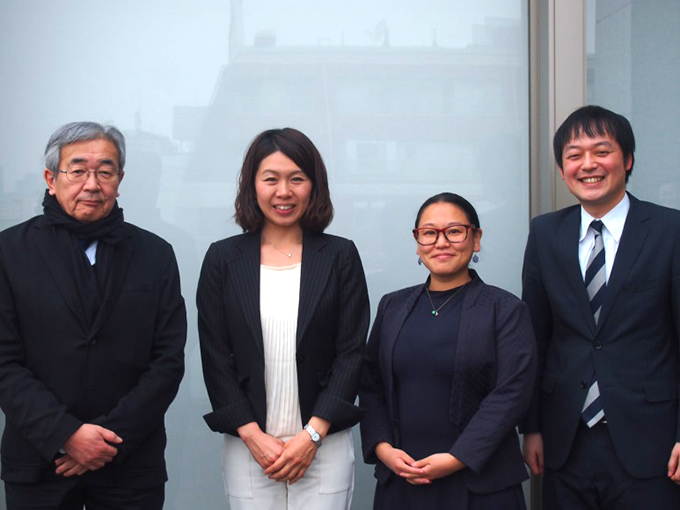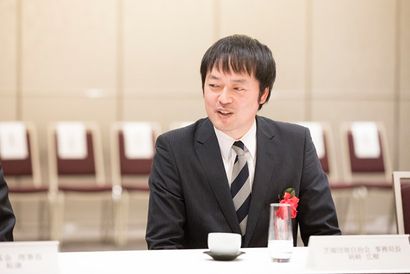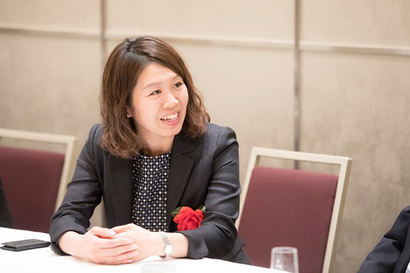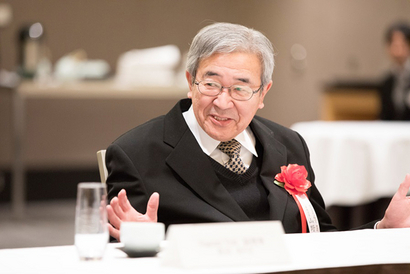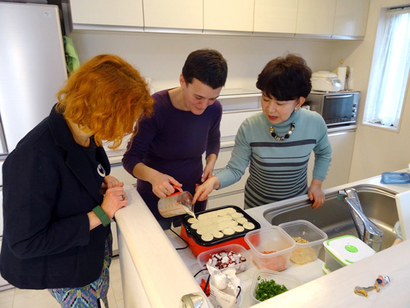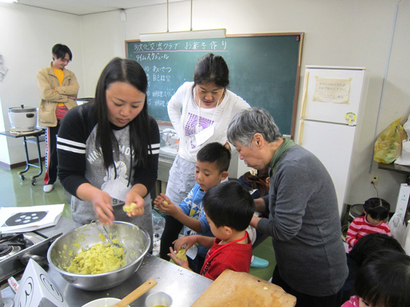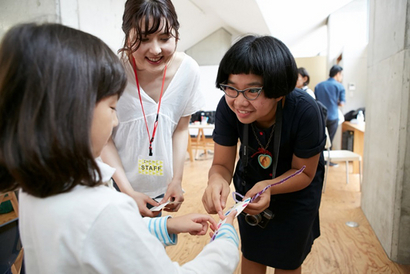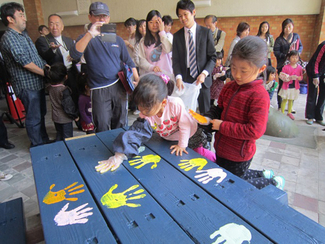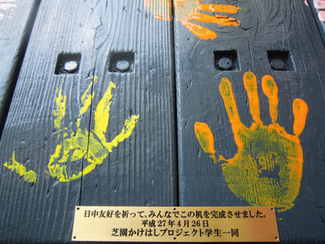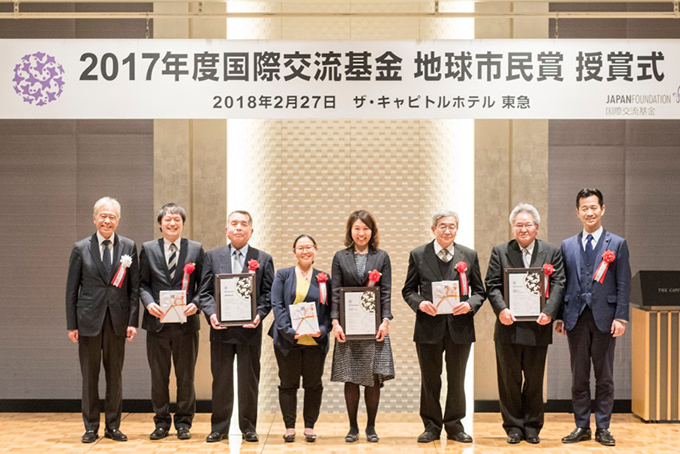What sort of multicultural society can we create in the near future by continuous action?
Hiroki Okazaki, Megumi Kusunoki, Alisa Sanada and Shingo Yamano
The Japan Foundation Prizes for Global Citizenship support organizations throughout Japan that conduct international cultural exchange activities. In fiscal 2017, three organizations were selected as recipients. Shibazono Danchi Neighborhood Association in the city of Kawaguchi, Saitama Prefecture focuses on exchange between Japanese residents and foreign residents. Nagomi Visit provides a service that matches foreign travelers with ordinary Japanese families who invite the travelers to their homes to share a meal. Koganecho Area Management Center has promoted community development through art in the Hatsunecho-Koganecho and Hinodecho area where illegal shops once lined the streets. Today, when the living environment has changed and multicultural coexistence is applauded, what kind of awareness of issues do these organizations have and what kinds of daily actions do they take? We talked to four key people involved in the operation of each organization.
From Left: Shingo Yamano, Director of Koganecho Area Management Center; Megumi Kusunoki, Founder and Chief Executive Officer of Nagomi Visit and its Chief Operating Officer, Alisa Sanada; and Hiroki Okazaki, Director of Shibazono Danchi Neighborhood Association
Trouble stemming from differences in lifestyle habits between Japan and other countries
―The neighborhood of Shibazono-cho in Kawaguchi, Saitama Prefecture has a residential population of approximately 4,800 (as of 2017), of which more than half are foreign residents. It would seem that active exchange is taking place at Shibazono Danchi apartment complex, such as having non-Japanese taking on official roles in the neighborhood association and holding Chinese-language classes. However, the reasons for awarding the Prize for Global Citizenship to this particular organization include the group's recognition that dissatisfaction among residents over matters such as differences in lifestyle habits had come to a head in 2011. Today, Mr. Hiroki Okazaki is visiting us as the representative of the Shibazono Danchi Neighborhood Association. What kind of problems were you actually facing?
Okazaki: Generally speaking, differences in daily living habits rose to the surface. In 2009, the number of foreign residents exceeded 2,000 and from that time there was an increase in issues involving how to dispose of trash, noise, and even cases of urine and feces in the corridors. Chinese make up 90% of foreign residents in Shibazono Danchi. In the rural areas of China people sometimes relieve themselves outside, and I think some people have continued that habit even in Japan. Compared to social etiquette in Japan, that was just too much, and the Urban Renaissance Agency, City Hall, and the residents' neighborhood association started talking together.
-- For sure, anyone would be bothered by feces lying around.
Okazaki: That's right. So, a person who could interpret Chinese was permanently placed in the management office, and they started giving information to Chinese when residents moved in and posting notices.
There are reasons for the increase in Chinese residents in Shibazono Danchi. The number of Chinese people such as exchange students rose from the latter half of the 1980s, and they started moving to livable Tokyo suburbs around the late 1990s. Also, around 2002 an examination system for IT technicians was mutually recognized between Japan and China, and more IT technicians came to Japan. These technicians, their families, and friends chose Shibazono Danchi as a place with a nice living environment. I think that kind of global trend has had an impact. There is no residential discrimination in the housing complex, and companies can lease housing as company dormitories, which probably also has a big impact.
-- Living among so many people, differences in customs like foods and traditions became even more apparent, right?
Okazaki: I began living in the housing complex in 2014. At the time, I felt the situation was somewhat settled because of efforts like installing a permanent interpreter. But, I also sensed there was distrust between the Japanese and foreigners. I thought it would be good if there were more opportunities for interaction and decided to participate in the neighborhood association.
Mr. Okazaki moved to Shibazono Danchi in 2014 and is now the director of the neighborhood association.
Photo: Kenichi Aikawa
Communication possibilities realized through home visits
-- I'd like to turn to Ms. Megumi Kusunoki, Founder and Chief Executive Officer of Nagomi Visit, and its Chief Operating Officer, Ms. Alisa Sanada. What kind of activities does Nagomi Visit carry out?
Kusunoki: We started in 2011. Personally, I was motivated because I wanted to give it a try. I had worked at a company running a website sharing tourist information in English, and the number of foreign tourists was rising fast before the earthquake (that hit Japan on March 11, 2011). Visiting tourist sites is very typical, but I wanted to provide an experience that would give them something more. When I traveled overseas, I had the most fun visiting the homes of local residents and being treated to dinner. You can get a better feel for that country and town, and become friendly on a personal level more than when touring sightseeing spots.
But, that's difficult to do if you don't know anyone. So, to test out my idea I got help from my colleagues at the time who were open to inviting a foreign guest over. We held a dinner that was a kind of model for Nagomi Visit.
-- What was the response?
Kusunoki: It was a surprisingly spirited dinner! Of course, people who speak English can communicate, but even if you can't understand the language, the mood becomes enjoyable if, for example, your taste in music happens to be the same. It's fun coming up with the names of musicians to share with each other. The fact that you can connect in that way was a huge revelation, and I rediscovered the meaning of having a home visit in Japan.
Right now, there are about 900 hosts throughout Japan that can accept visitors, and the main task of Nagomi Visit is to match them with foreign tourists online.
Founder and Chief Executive Officer Kusunoki began Nagomi Visit based on her own experiences.
Photo: Kenichi Aikawa
An art project that came out of a course of events
-- Mr. Yamano, you've been director of Koganecho Area Management Center for many years. You've turned the Hatsunecho-Koganecho and Hinodecho area into an art area and created an environment where artists from Japan and abroad can live and produce art, and have implemented various events and exhibitions. What were the reasons you originally became involved in this work?
Yamano: The truth is, at first there was kind of a tricky aspect to it. Illegal businesses operated in this area for a long time, and about 10 years ago there was a concentrated campaign to shut them down all at once. Then the issue raised was what to do with the resulting empty houses. Apparently, the plan turned to creating an area where artists and creators would gather. I learned of that intention later (laughs).
When I was first invited to join, I was asked to plan an exhibition that used the culture facilities newly built under tracks and the empty homes. That was held in 2008, and quite a few people came, but once it was over the spaces would again be deserted. That was when the government said to me for the first time, "We'd like to create an NPO that integrates the community and art initiatives. We want to have artists in residence, so please stay on!"
-- From the perspective of people familiar with the present-day Koganecho neighborhood, that's an unexpected past, isn't it? I got the impression that Mr. Okazaki from Shibazono Danchi and the two representatives from Nagomi Visit actively started their endeavors, but your story is a little different.
Yamano: It wasn't self-driven (smiles wryly). I'd never been to Koganecho until I was asked to plan the exhibition, and I'm not even an expert in community development. But, when I was asked to launch the NPO, strangely enough, I thought to myself that I was the only one who could do it.
-- Why was that?
Yamano: A sense of balance is required when you attempt to do something in a community. Various elements are intertwined--artists, the local community, as well as the government and police. If only a curator is involved, then ideas come from an art-based approach that is only concerned with having a good exhibition. Artists wanting to do something drastic might go unchecked. This gives rise to lots of conflict with others. Since the 1990s, I've learned how to develop programs while splitting the difference and planning exhibitions in urban communities. I thought I could use that experience at Koganecho.
Director Yamano utilized his experiences planning exhibitions in urban communities and became involved in launching Koganecho Area Management Center.
Photo: Kenichi Aikawa
How you see others, lack of mutual understanding
Kusunoki: In our case, we didn't have any past achievements, but I think we were able to start because of strong personal desire. Sanada and I were originally colleagues at the same company and had internet-related knowledge and skills. Since guests are foreign tourists, using the internet was the most important, and we had those skills. That played a big part.
Sanada: When I found out Kusunoki was going to launch Nagomi Visit, I enthusiastically joined, wanting to help in any way I could. I quit the company even before she did and was in the middle of a round-the-world trip. In South Africa, I stayed at local's homes and was in a position to understand how a guest feels. Immediately after returning to Japan, I started helping by writing host family profiles in English.
I'm Japanese American and was born and raised in America. Even now, foreigners who live in Japan are often stared at which makes them feel like Japanese people do not understand them. For that reason and others I've long personally felt that I'd like to make Japan an easier place to live in. If the kinds of activities carried out by Nagomi Visit become energized, the number of foreigners visiting Japan will increase, and opportunities to interact closely with Japanese people will also increase. I think it's easier to take these gradual steps than for Japanese and foreign residents to live next to each other right off the bat.
Kusunoki: My husband is Danish. He's lived in Japan a long time and is fluent in Japanese, but he still gets looked at differently. For example, when we check into a Japanese inn, even though we made the reservation in his name, the person at the front desk talks to me, the Japanese person. Of course, I understand the person might be shy about making eye contact or worried if something is said to him in English, but every time something like that happens I feel ashamed about how Japanese people treat foreigners. As a way to change that, I think Nagomi Visit is a great system that brings together guests and hosts with common needs.
Through the service provided by Nagomi Visit, foreign tourists can experience visiting an ordinary home in Japan.
-- Mr. Okazaki, in your neighborhood not everyone shares the same feelings, do they? Are there any difficulties because of that?
Okazaki: It's difficult. In any case, the problem is simple. People are upset, not because someone is Chinese or a foreigner, but because they are angry with the troublemaker next door. As the Japanese people see it, they're being inconvenienced by Chinese people who bring over lifestyle habits that differ from Japan. But, from the Chinese people's perspective, even though they're living the same way as in their home country and have no ill will, they receive complaints without knowing what's wrong. They feel they're being unilaterally condemned.
After becoming a resident in the housing complex and listening to what both the Japanese and Chinese people have to say, I think that both sides are angry and confused. Rather than discrimination and prejudice, they became bothered and then angry because they can't understand one another. When you comprehend that, then you realize you can't take one side over another because when you see each point of view, then the anger of both sides appears reasonable.
-- Each feels as if they're being attacked, so you can't easily tell who is in the right.
Okazaki: At the same time, I was certain that if nothing was done, then they wouldn't interact. Even if the situation calmed down, it was very possible that some kind of incident would be a trigger and the situation would get worse. So, I wanted to actively create chances to interact so that the bad feelings wouldn't fester.
Shibazono Danchi actively creates opportunities for Japanese and Chinese residents to interact.
Change and realizations that come through interaction
Yamano: Listening to Mr. Okazaki, I truly feel it must be tough. In Koganecho, there are people in the community who support our activities, people who are noncommittal, and people who keenly oppose them. Of course, there are also those who want the community to go back to the way it was. But, our stance as an NPO is that we can't connect people with conflicting opinions because of differing character. When we take action, we have to work together with the government and police with a shared objective. An NPO has to state quite clearly what is good and what is bad.
We sometimes get caught up in difficulties, but on the other hand, there are those that can easily overcome them--the artists. Surprisingly, it's the artists who sympathize with various situations and easily create a place for themselves that connects them with different people while observing the community as a whole.
When first launching activities in Koganecho, I thought a long time about the best way to get artists comfortable in the community. I expected they wouldn't be able to form relationships unless our NPO purposefully took some kind of action. However, the artists were much quicker to form relationships.
It is the artists that connect and create relationships with people in the Koganecho community who have various opinions.
-- Perhaps being an individual and coming from outside the community gives artists courage and adaptability.
Yamano: I'm now certain that the role of artists in the community is in reality considerably important. Many people are pretty interested in the artists even if they're not interested in the art. That includes children.
Therefore, recently I've been thinking about having artists permanently move to the community instead of staying temporarily. Like Shibazono Danchi, there is a growing number of foreigners in Koganecho. New Japanese residents are also increasing, so the sense of unity in the community is steadily waning. The ticket to not losing that sense of unity is the vision of having artists settling in the neighborhood and growing their numbers.
Okazaki: I think I understand. Our first act to promote exchange was to hold disaster prevention workshops. I didn't think too many people would join, but surprisingly many participated, by Japanese and foreigners. After that, we did things like plan an international exchange event, and when we asked foreigners living in the housing complex to set up a booth, they did. Even more people participated when we tried launching the Shibazono Kakehashi Project with students. In other words, everyone wants to participate if given the opportunity. Naturally, it's quite difficult to take the initiative and start something, so the neighborhood association has to take the lead, but people will gather together when an opportunity is provided. And, gathering together brings to light the next issues and problems to be tackled.
At an event devised by the Shibazono Kakehashi Project, residents created artistic desks by imprinting colorful handprints on desks that had been covered with discriminatory graffiti.
Continuing small actions is more important than big dreams
-- What are everyone's goals going forward?
Kusunoki: This is the 7th year since launching Nagomi Visit, but my goal of growing the number of participants hasn't changed. My initial three-year business objectives have only been achieved up to about the 2nd year and half, so there are still so many things to do. But, I was surprised at the response, which exceeded what I'd imagined. There are host families that say their life has changed since experiencing Nagomi, and even people who have continued exchange with the guests and visited the guests' homes in their countries!
-- The exchange is spontaneously spreading.
Sanada: And, the reason we can continue is because from the start we set things up so that all the work can be completed online. Nearly all the work is done by us two, but now we've been able to ask a team member living in Brazil to do clerical work, and I can also do work wherever I'm traveling overseas. When a woman has a child, her lifestyle can't help but change in many areas. This kind of job is great because it can adapt to that.
Okazaki: In the future, Japan will undoubtedly become a society of multicultural coexistence. As the community becomes made up of not only first-generation foreigners, but also their families, who become second and third-generation residents, various customs, education, and lifestyles will likely intermingle, and problems will unavoidably flare up. I really understand that now after living in Shibazono Danchi for four years. That's not a big problem, but a problem that's close at hand.
Ideally, if we talk it out we should be able to understand each other, but in reality that's not true. Personally and as a community we'll move as much as possible in a positive direction while associating in close proximity with one another. That's extremely difficult, but if we don't make steady progress there will certainly be more discrimination and exclusion of the kind that happens in other countries. I understand that, so personally I'll continue to focus on taking steadfast action.
Kusunoki: I can really relate to that. My daughter was born last year. She's half Japanese, so she looks quite foreign. For a year, since she's been born, I've been told she looks mixed.
With that, I feel I'm now on the receiving end. As a parent, there will probably be times when I'll talk about how she may be seen in Japanese society. When that happens, I don't want to have to talk while feeling ashamed of Japan, like I mentioned earlier. So, I hope that Japan will become a society of multicultural coexistence as soon as possible. That's a big dream, but if we can steadily increase home visits, I think Japan will change little by little.
Sanada: The phrase "international exchange" sounds imposing. To start with, if you're a Japanese person living in Japan, you don't have to actively associate with foreigners. However, I've recently begun to think that if you'd like to change the current situation, you should do it through communication that is naturally exciting and stimulates curiosity. In America, the movie Black Panther is a huge hit. The hero is black and the setting is a fictional country where everyone lives with pride in being an African. It's very effective when that kind of ordinary and accessible thing, like pop culture, cues people to think about the issues that come up with international exchange.
Yamano: Koganecho is a neighborhood of many nationalities, and during the yearly "Koganecho Bazaar," artists, primarily Asian, are invited and people of various ethnic groups intentionally live together for three months.
Through this event, artists from Japan and other countries become close and keep in touch even after it's over, with Japanese people going to visit the other person's country. I think repeating this kind of action will encourage future exchange, so I hope to maintain the environment that enables this on into the future. Artists and people involved in Koganecho touch various communities to create connections left and right that return to them or take flight in other directions. Perhaps my only wish is that this environment continues for a long time.
Award ceremony for the 2017 Japan Foundation Prizes for Global Citizenship (February 27, 2018)
Photo: Kenichi Aikawa
Interview/text: Taisuke Shimanuki
Shibazono Danchi Neighborhood Association (Facebook):
https://www.facebook.com/shibazonokakehashiproject/
Nagomi Visit (NPO): http://www.nagomivisit.com/
Kogane-cho Area Management Center (NPO): http://www.koganecho.net/info/english.html
Related Articles
Back Issues
- 2025.6.24 Exclusive Interview:…
- 2025.5. 1 Ukrainian-Japanese I…
- 2024.11. 1 Placed together, we …
- 2024.5.24 The 50th Japan Found…
- 2024.5.24 The 50th Japan Found…
- 2024.5. 2 People-to-People Exc…
- 2024.2.19 Movie Theaters aroun…
- 2024.2.19 Movie Theaters aroun…
- 2023.4.24 The 49th Japan Found…
- 2022.10.24 Inner Diversity <2> …


